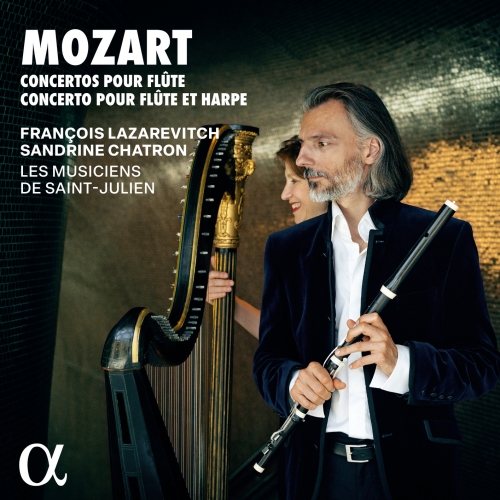François Lazarevitch, Sandrine Chatron, Les Musiciens de Saint-Julien - Mozart: Concertos pour flûte & Concerto pour flûte et harpe (2024) [Hi-Res]

Artist: François Lazarevitch, Sandrine Chatron, Les Musiciens de Saint-Julien
Title: Mozart: Concertos pour flûte & Concerto pour flûte et harpe
Year Of Release: 2024
Label: Alpha Classics
Genre: Classical
Quality: FLAC (tracks) / 24bit-96kHz FLAC (tracks+booklet)
Total Time: 01:10:30
Total Size: 302 MB / 1.23 GB
WebSite: Album Preview
Tracklist:Title: Mozart: Concertos pour flûte & Concerto pour flûte et harpe
Year Of Release: 2024
Label: Alpha Classics
Genre: Classical
Quality: FLAC (tracks) / 24bit-96kHz FLAC (tracks+booklet)
Total Time: 01:10:30
Total Size: 302 MB / 1.23 GB
WebSite: Album Preview
1. Mozart: Flute Concerto in D Major, K. 314: I. Allegro aperto (6:56)
2. Mozart: Flute Concerto in D Major, K. 314: II. Adagio non troppo (5:53)
3. Mozart: Flute Concerto in D Major, K. 314: III. Rondo. Allegretto (6:20)
4. Mozart: Flute and Harp Concerto in C Major, K. 299: I. Allegro (10:12)
5. Mozart: Flute and Harp Concerto in C Major, K. 299: II. Andantino (7:47)
6. Mozart: Flute and Harp Concerto in C Major, K. 299: III. Rondeau. Allegro (9:45)
7. Mozart: Flute Concerto in G Major, K. 313: I. Allegro maestoso (8:24)
8. Mozart: Flute Concerto in G Major, K. 313: II. Adagio ma non troppo (7:49)
9. Mozart: Flute Concerto in G Major, K. 313: III. Rondo. Tempo di Menuetto (7:27)
Mozart's flute concertos are of course a Holy Grail for flutist Francois Lazarevitch, one that he has decided to tackle together with his ensemble Les Musiciens de Saint-Julien in connection with their work on sources of interpretation. He has recorded the two concertos for flute and orchestra on a one-keyed flute, a copy of an instrument made in Mozart's time, and the concerto in C for flute and harp on an eight-keyed flute -- a flute with a C foot -- with Sandrine Chatron playing a period harp by Francois-Joseph Naderman. As Mozart left no original cadenzas for the flute concertos, Francois Lazarevitch has here created his own, drawing inspiration from the cadenzas Mozart composed for his piano concertos. The Menuets and Gavottes in the final movements are particularly highlighted by the ensemble's expertise in music for dancing: "after a first movement that is a little solemn and a second that is more lyrical, the final movements are often a moment for release in dance," concludes Lazarevitch.

![Steinar Raknes Quartet - Live in Tokyo (2013) [Hi-Res] Steinar Raknes Quartet - Live in Tokyo (2013) [Hi-Res]](https://www.dibpic.com/uploads/posts/2025-12/1766420385_steinar-raknes-quartet-live-in-tokyo-2013.jpg)

![Iman Spaargaren & Peter Bjørnild - In Essence (2025) [DSD256] Iman Spaargaren & Peter Bjørnild - In Essence (2025) [DSD256]](https://www.dibpic.com/uploads/posts/2025-12/1766381912_cover.jpg)




![Dorothy Donegan - World Recording Sessions 1944/45 (Mono Remastered) (2025) [Hi-Res] Dorothy Donegan - World Recording Sessions 1944/45 (Mono Remastered) (2025) [Hi-Res]](https://www.dibpic.com/uploads/posts/2025-12/1766499237_folder.jpg)